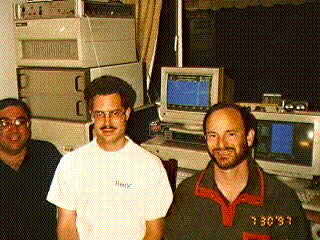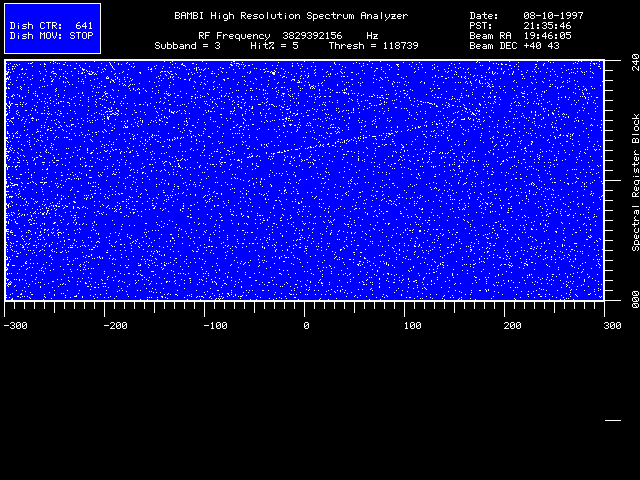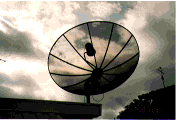 |
Amateur SETI:
Project BAMBI |
 |
Amateur SETI:
Project BAMBI |
Take a look at what's
new with Project BAMBI. (Updated November 23rd, 2013)
Download the
BAMBI
Printed Circuit Board Layouts.
Download the BAMBI
Software Collection.
View the BAMBI
Schematics.
Join
the search with your own PC,
through the SETI@home project!
The Project BAMBI Team:

Example BAMBI Waterfall Drifting CW Detection (Terrestrial Origin)
Can you find it? A faint 3.8 GHz drifting continuous wave (CW) narrow band signal is visible below. Although this signal was of terrestrial origin (you are looking at the 30th harmonic of an ovenized 128 MHz TTL oscillator soldered to a resistor lead, mounted two yards BEHIND the dish for high attenuation, mixed with actual sky signal at RA 19:46:05 DEC +40 43), we are searching for real signals that have a similar drifting CW characteristic due to possible doppler shift.
The horizontal axis of this display block corresponds to 600 channels (1 Hz per channel), and the vertical axis represents time (240 lines at 2 seconds per line). The slope of this signal is approximately + 3 Hz per second, with an inflection reversing to - 3 Hz per second. Unlike this test signal, a real extraterrestial source would be expected to maintain a constant slope.

BAMBI Sites:

BAMBI Overview:
The following article, complete with
figures, was originally published
in the June/July 1994 issue of
Radio
Astronomy,
The Journal of the Society of Amateur
Radio Astronomers, pp. 1-6.

Abstract The design, construction, and initial observational results of a 4 GHz amateur radio telescope are described in this first report from Project BAMBI (Bob And Mike's Big Investment). The system is now operating continuously. The planned extension of the BAMBI project to amateur SETI is also discussed. Introduction A number of efforts are underway in the Search for Extraterrestrial Intelligence (SETI). We have been deeply interested in the search for some time, and have concluded that amateurs can in fact construct affordable systems with sensitivities comparable to professional all-sky search strategies even with antennas of limited aperture. We have also concluded that we can achieve a reasonably respectable frequency coverage of a search spectrum as well. We hope this project will encourage other amateurs to join in the search. Project BAMBI is divided into two phases: Phase I: Standard Amateur Radio Astronomy: We have initially operated BAMBI as a total power receiver for several crucial reasons. Most importantly, it has been a lot of fun. Many of you must have experienced this same indescribable, goose-bump raising feeling, when you realize you are actually detecting radio emissions from a source almost a billion light years away (e.g. Cygnus A). Also, we confirmed that the front end of the system actually worked, and calibrated our pointing accuracy. We are now looking for the lower limit of our sensitivity, which will allow us to better estimate our actual system temperature for purposes of Phase II. Phase II: Narrow Band SETI: You will notice that BAMBI has a number of features that, while not required or even necessarily optimal for a total power receiver, are essential for SETI. The incorporation of a 25 degree K LNB front end, and an inexpensive spectrum analyzer in the IF pathway make the telescope "SETI-Capable". In Phase II, the spectrum analyzer will be used as a PC-controlled tuner, funneling a "block" of frequencies to BAMBI's analog-to-digital converter. An FFT will then be performed to break the block up into narrow channels on the order of 0.8 Hz each, and the results will be passed on to detection software to log possible "hits". The smaller aperture antenna actually enjoys a benefit for SETI use; the wider beam width means that sources will stay in the beam longer allowing a wider spectrum to be examined. When promising "hits" occur, one of the ways we can help distinguish them from terrestrial noise is by repeatedly scanning for the frequency drift expected due to the doppler shift caused by the earth's rotation and possibly that of the source. Background: Amateur Radio Astronomy at 4 GHz The radio sky at 4 GHz is an interesting place. While sources emitting by the synchrotron process (e.g. supernova remnants and radio galaxies) are less intense than at lower frequencies, thermal sources such as hot ionized gas clouds (H II regions where new stars are forming) and other thermal emissions from the plane of the galaxy are actually stronger. A big benefit to the amateur radio astronomer at 4 GHz is the narrower half-power beam width obtainable with even a modest sized antenna (1.9 degrees for our 8.5 foot parabolic dish) than at lower observing frequencies, and the ready availability of inexpensive state-of-the-art low noise amplifiers, feeds, antennas, and positioners mass produced by the TVRO industry for satellite TV reception. Design An overview of the design is illustrated in figure 1. An off-the-shelf 8.5 foot parabolic antenna with a built-in horizon-to-horizon positioner was pole mounted and oriented to sweep in a north-south arc covering a usable declination range of +90 to -42 degrees. The telescope's IBM-PC clone moves the antenna to the desired declination automatically using a standard positioner control unit. A 25 degree K HEMT GaAsFET LNB (3.7 to 4.2 GHz broadband input, 62 dB gain, complete with built-in down converter producing 950 to 1450 MHz output) with attached Chaparral style circular feed was mounted at the focus. Cabling was run indoors and the signal was down converted to the 225 to 725 MHz range using a mixer driven by a 725 MHz local oscillator. The signal was then supplied to an inexpensive 0.1 to 810 MHz spectrum analyzer plug-in card for IBM-PC's (built from a kit featured in the August 1991 issue of Radio Electronics Magazine and available from DKD Instruments). This card consists of a CATV type tuner and two NE615 receiver / IF Amplifier stages providing about 55 dB of gain in our application. The output of the 1st IF stage (now at a bandwidth of 280 KHz centered at 455 KHz) was then coupled to two wide band op-amp gain stages (for 20X and 12X voltage gain) and then sent to a square law detector circuit. This was then buffered by a unity gain voltage follower, and sent to an integrator with a 70X gain and a 30 second integration time. Baseline adjustment is accomplished automatically by means of a computer controlled 8-bit D/A converter driving an offset adjust circuit (it algebraically subtracts the D/A output voltage from the signal). A DC amplifier stage delivering 50X gain provides the final signal to an 8-bit A/D converter attached to an IBM-PC. Total power data is logged at 30 second intervals. The log files are time averaged over a series of scan nights and the results are shown graphically on a PC.
Construction If you have some familiarity with analog and digital electronics as well as programming, you should be able to build a system similar to BAMBI. We are both electronics and computer hobbyists (yes, we did later get degrees in electrical engineering and computer science, but that sort of academic background is not necessary to build a working system). All of the front end electronics (from the antenna up to the IBM-PC spectrum analyzer card) are pre-made items that were patched together using F and N type jumper cables. Even the spectrum analyzer can be obtained pre-built if desired. The kit construction proceeded flawlessly, but we cracked one of the IF transformer cores with a metal screwdriver during the initial tuning and had to replace it (be sure to invest $1.25 for the recommended TOKO plastic adjusting tool!). The remaining electronics were assembled on a small breadboard, and the layout was not critical because the signal at this stage is very low frequency. The indoor electronics were placed in two rack mount bays (see photos) and attached to a dedicated IBM-PC. A second IBM-PC (on the right side of the photo) is used for time averaging analysis, display, and other development work, so that the telescope can continue observations without interruption. Initial Observational Results After checking out the system on a TVRO satellite (ANIK-E2) and the sun, we then realized we still needed some more gain, and added the two above- mentioned IF amp stages that follow the spectrum analyzer. We then reobserved the sun (fig. 2), and as you can see the signal was so strong that it pegged off scale and illuminated the antenna sidelobes.
Fig. 2 - Solar Transit
After kicking up the post-detector amplitude to about 70 mV, we then successfully observed Cassiopeia A (figs. 3 & 4), Taurus A (fig. 5), Cygnus A (fig. 6), and Virgo A (fig. 7). The published strength of these sources at 4 GHz are listed below:
| Object | Flux at 600 MHz (Jy) | Flux at 4 GHz (Jy) |
| (Ref. 1) | (Ref. 2) | |
| CASS A | 4756 | 1086 |
| TAU A | 1090 | 687 |
| CYG A | 2944 | 459 |
| VIR A | 396 | 84 |
Fig 3. - Cassiopeia A, six separate scan night plotted
Fig. 4 - Cassiopeia A, time average of six scan nights
Fig. 5 - Taurus A (Crab Nebula), average of six scans
Fig. 6 - Cygnus A, average of seven scans
Fig. 7 - Virgo A, average of ten scans
The observations for Cass A in figure 3 show the individual plots obtained over 6 separate nights. Figure 4 shows the dramatic reduction in noise that occurs when the 6 nights are time averaged together. The remaining objects shown are also time averaged. In the Cygnus A plot (fig. 6), it is interesting to note that the Cygnus arm of the galaxy (the spiral arm we are in) is also clearly seen. The transients seen prior to and following the Virgo A detection (fig. 7) are due to baseline adjustment artifact. This source was close to the sun causing more frequent baseline compensation due to thermal changes. We are now beginning to search for weaker sources to find the practical limit of our sensitivity. Planned Extension to Amateur SETI As mentioned earlier, and quite remarkably, amateurs can obtain sensitivities comparable to NASA's all-sky search (which we were saddened to learn was recently cancelled due to budget constraints), even using small antennas, by means of applying the FFT to break the signal up into channels significantly narrower than what NASA was using (e.g. using 0.6 to 1 Hz vs. 20 to 32 Hz channels). Man-made radio signals such as the strongest military RADAR systems radiate 14,000 megawatts into a bandwidth of 0.1 Hz. Even ordinary TV carriers concentrate about half their power in a very narrow band of 0.1 to 1 Hz (ref. 3). This narrow band detection approach provides a dramatic boost in the signal-to-noise ratio which significantly compensates for the smaller aperture dish. The next phase of project BAMBI will be to run a high resolution FFT spectral analysis on the output of the spectrum analyzer in a search for narrow band carriers not found from natural radio sources. This will initially be carried out in software, and later will be implemented using a dedicated FFT processor chip which was donated to the project. We will submit updates as the project continues. Resources You can download the BAMBI Software Collection right here.View the BAMBI Schematics.
Other resources: DKD Instruments (810A Spectrum Analyzer IBM-PC Plug-In) 750 Amber Way Nipomo Ca. 93444 (805) 929-2285 Fax (805) 929-5983
Orbitron (SX-8.5 TVRO Antenna) (Available from Skyvision) 351 S. Peterson St., Spring Green, WI 53588 (608) 588-2923 Chaparral Communications (Polarotor Feedhorn) (Available from Skyvision) 2450 North First St., San Jose, CA 95131 (408) 435-1530 California Amplifier (25 Deg. K LNB) (Available from Skyvision) 460 Calle San Pablo, Camarillo, CA 93012 (805) 987-9000 Vigar Electronics (Surplus source of Cal. Microwave L.O.) 242-01 Alameda Ave., Douglaston, N.Y. 11363 (718) 423-1906 California Microwave (Very helpful with info on their PC7PL T.C.X.O. Local Oscillator) (408) 732-4000 Mini-Circuits (ZFM-150 Mixer) P.O. Box 350166, Brooklyn, NY, 11235-0003 (718) 934-4500 References 1. Sickels, R.M., Radio Astronomy Handbook, Catalog of 400 Radio Sources, pp. 296-299, 1989 2. Baars, J., et. al., The Absolute Spectrum of Cas A; An Accurate Flux Density Scale and a Set of Secondary Calibrators, Astronomy and Astrophysics, 61:99-106, 1977 3. Papagiannis, M. (ed.), The Search for Extraterrestrial Life; Recent Developments, Proceedings IAU Symposium 112, pp. 263-270, 1984
Bob Lash's personal homepage is here.
See the BAMBI Observations of Comet Shoemaker/Levy-9's Impact on Jupiter!
BAMBI Home | What's New | Software | Jupiter Observations | SARA / Amateur Radio Astronomy